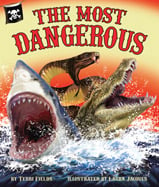Alignment to Standards for LA

| Grade | Number | Standard |
|---|---|---|
| 1 | G-1.1 | Identify and use simple map symbols and key/legend |
| 1 | G-1.3 | Describe a map as a representation of a place |
| 1 | LS-1.26 | Describe the differences between plants and animals |
| 1 | LS-1.32 | Describe features of some animals that benefit them in their environments |
| 2 | G-2.2 | Describe basic characteristics of maps and globes |
| 2 | LS-2.30 | Identify physical characteristics of organisms (e.g., worms, amphibians, plants) |
| 2 | LS-2.34 | Describe inherited characteristics of living things |
| 2 | LS-2.35 | Identify the components of a variety of habitats and describe how organisms in those habitats depend on each other |
| 3 | G-3.1 | Describe characteristics and uses of various maps (e.g., physical, political, topographical, population) |
| 3 | LS-3.35 | Compare structures (parts of the body) in a variety of animals (e.g., fish, mammals, reptiles, amphibians, birds, insects) |
| 3 | LS-3.38 | Classify groups of organisms based on common characteristics |
| 3 | LS-3.39 | Compare organisms from different groups (e.g., birds with mammals, terrestrial plants with aquatic plants) |
| 4 | LS-4.41 | Describe how parts of animalsê bodies are related to their functions and survival (e.g., wings/flying, webbed feet/swimming) |
| 4 | LS-4.48 | Classify examples of plants and animals based on a variety of criteria |
| 4 | LS-4.52 | Describe how some plants and animals have adapted to their habitats |
| 5 | LS-5.24. | Describe the roles of producers, consumers, and decomposers in a food chain |
| 5 | LS-5.28. | Explain and give examples of predator/prey relationships |
| K | G-K.1 | Identify a map and a globe as a representation of Earth |
| K | G-K.5 | Identify the difference between land and water and locate both on a map or globe |
| PK | LS-PK.20 | Give examples of different kinds of plants and different kinds of animals |
| PK | LS-PK.22. | Learn about animals and plants through nonfiction literature (For Creative Minds) |